Assessment of Soil Nutrients in Plant Root Layer of a Saline-Sodic Soil Cropped with Lycium barbarum L. When Drip Irrigated with Saline Groundwater
Abstract
1. Introduction
2. Materials and Methods
2.1. Experiment Site
2.2. Agronomic Practice
2.3. Experiment Design
2.4. Measurements
2.5. Data Analysis
3. Results
3.1. Spatiotemporal Changes in TN in Soil Profiles
3.2. Spatiotemporal Changes TP in Soil Profile
3.3. Spatiotemporal Changes in SOM in the Soil Profile
4. Discussion
5. Conclusions
Author Contributions
Funding
Data Availability Statement
Conflicts of Interest
References
- Heng, T.; He, X.L.; Yang, L.L.; Xu, X.; Feng, Y. Mechanism of Saline–Alkali land improvement using subsurface pipe and vertical well drainage measures and its response to agricultural soil ecosystem. Environ. Pollut. 2022, 293, 118583. [Google Scholar] [CrossRef] [PubMed]
- Muhammad ESh Ibrahim, M.M.; El-Sayed, A. Effects of drain depth on crop yields and salinity in subsurface drainage in Nile Delta of Egypt. Ain Shams Eng. J. 2021, 12, 1595–1606. [Google Scholar] [CrossRef]
- Mukhopadhyay, R.; Fagodiya, R.K.; Prajapat, K.; Narjary, B.; Kumar, S.; Singh, R.K.; Bundela, D.S.; Barman, A. Sub-surface drainage: A win-win technology for achieving carbon neutrality and land amelioration in salt-affected Vertisols of India. Geoderma Reg. 2023, 35, e00708. [Google Scholar] [CrossRef]
- Du, X.J.; Hu, H.; Wang, T.H.; Zou, L.; Zhou, W.F.; Gao, H.X.; Ren, X.Q.; Wang, J.; Hu, S.W. Long-term rice cultivation increases contributions of plant and microbial-derived carbon to soil organic carbon in saline-sodic soils. Sci. Total Environ. 2023, 904, 166713. [Google Scholar] [CrossRef]
- Xu, Z.K.; Shao, T.Y.; Lv, Z.X.; Yue, Y.; Liu, A.H.; Long, X.H.; Zhou, Z.S.; Gao, X.M.; Rengel, Z. The mechanisms of improving coastal saline soils by planting rice. Sci. Total Environ. 2020, 703, 135529. [Google Scholar] [CrossRef] [PubMed]
- Guo, K.; Liu, X. Salt leaching process in coastal saline soil by infiltration of melting saline ice under field conditions. J. Soil. Water Conserv. 2020, 75, 549–562. [Google Scholar] [CrossRef]
- Zhang, C.; Li, X.; Kang, Y.; Wang, X. Salt leaching and response of Dianthus chinensis L. to saline water drip-irrigation in two coastal saline soils. Agric. Water Manag. 2019, 218, 8–16. [Google Scholar] [CrossRef]
- Singh, A. Soil salinization management for sustainable development: A review. J. Environ. Manag. 2021, 277, 111383. [Google Scholar] [CrossRef] [PubMed]
- Rajput, T.B.S.; Patel, N. Water and nitrate movement in drip-irrigated onion under fertigation and irrigation treatments. Agric. Water Manag. 2006, 79, 293–311. [Google Scholar] [CrossRef]
- Dou, C.Y.; Kang, Y.H.; Wan, S.Q.; Hu, W. Soil salinity changes under cropping with Lycium barbarum L. and irrigation with saline-sodic water. Pedosphere 2011, 21, 539–548. [Google Scholar] [CrossRef]
- Wang, R.S.; Kang, Y.H.; Wan, S.Q. Effects of different drip irrigation regimes on saline–sodic soil nutrients and cotton yield in an arid region of Northwest China. Agric. Water Manag. 2015, 153, 1–8. [Google Scholar] [CrossRef]
- Kahlon, M.S.; Josan, A.S.; Khera, K.L. A comparative study on soil and plant parameters under furrow and drip irrigated tomatoes with poor quality water. Res. Crop 2008, 9, 61–72. [Google Scholar]
- Singh, A. Waterlogging and salinity management for sustainable irrigated agriculture. I: Overview, implication, and plant response. J. Irrig. Drain. Eng. 2017, 143, 04017035. [Google Scholar] [CrossRef]
- Yan, H.J.; Hui, X.; Li, M.N.; Xu, Y.C. Development in sprinkler irrigation technology in China. Irrig. Drain. 2020, 69, 75–87. [Google Scholar] [CrossRef]
- Dong, S.D.; Wang, G.M.; Kang, Y.H.; Ma, Q.; Wan, S.Q. Soil water and salinity dynamics under the improved drip-irrigation scheduling for ecological restoration in the saline area of Yellow River basin. Agric. Water Manag. 2022, 264, 107255. [Google Scholar] [CrossRef]
- Kang, Y.H.; Chen, M.; Wan, S.Q. Effects of drip irrigation with saline water on waxy maize (Zea mays L. var. ceratina Kulesh) in North China Plain. Agric. Water Manag. 2010, 97, 1303–1309. [Google Scholar] [CrossRef]
- Dong, S.D.; Wan, S.Q.; Kang, Y.H.; Sun, J.X. Effect of different soil matric potentials on distribution of soil salt and growth of Poplar (Populus) by drip irrigation in low-lying saline area. J. Soil. Water Conserv. 2017, 31, 236–247. [Google Scholar] [CrossRef]
- Dong, S.D.; Wan, S.; Kang, Y.; Li, X.B. Prospects of using drip irrigation for ecological conservation and reclaiming highly saline soils at the edge of Yinchuan Plain. Agric. Water Manag. 2020, 239, 106255. [Google Scholar] [CrossRef]
- Li, D.; Wan, S.; Li, X.; Kang, Y.; Han, X. Effect of water-salt regulation drip irrigation with saline water on tomato quality in an arid region. Agric. Water Manag. 2022, 261, 107347. [Google Scholar] [CrossRef]
- Merril, S.D.; Liebig, M.A.; Tanaka, D.L.; Krupinsky, J.M.; Hanson, J.D. Comparison of soil quality and productivity at two sites differing in profile structure and topsoil properties. Agric. Ecosyst. Environ. 2013, 179, 53–61. [Google Scholar] [CrossRef]
- Askari, M.S.; Holden, N.M. Quantitative soil quality indexing of temperate arable management systems. Soil. Tillage Res. 2015, 150, 57–67. [Google Scholar] [CrossRef]
- Sun, Z.X.; Zheng, J.M.; Sun, W.T. Coupled effects of soil water and nutrients on growth and yields of maize plants in a Semi-Arid region. Pedosphere 2009, 19, 673–680. [Google Scholar] [CrossRef]
- Chen, Y.; Jiang, Z.; Ou, J.; Liu, F.; Cai, G.; Tan, K.; Wang, X. Nitrogen substitution practice improves soil quality of red soil (Ultisols) in South China by affecting soil properties and microbial community composition. Soil. Till Res. 2024, 240, 106089. [Google Scholar] [CrossRef]
- Bouras, H.; Mamassi, A.; Devkota, K.P.; Choukr-Allah, R.; Bouazzama, B. Integrated effect of saline water irrigation and phosphorus fertilization practices on wheat (Triticum aestivum) growth, productivity, nutrient content and soil proprieties under dryland farming. Plant Stress. 2023, 10, 100295. [Google Scholar] [CrossRef]
- Xing, J.; Li, X.Y.; Li, Z.Q.; Wang, X.T.; Hou, B.; Li, D.P. Remediation of soda-saline-alkali soil through soil amendments: Microbially mediated carbon and nitrogen cycles and remediation mechanisms. Sci. Total Environ. 2024, 924, 171641. [Google Scholar] [CrossRef] [PubMed]
- Malone, Z.; Berhe, A.A.; Ryals, R. Impacts of organic matter amendments on urban soil carbon and soil quality: A meta-analysis. J. Clean. Prod. 2023, 419, 138148. [Google Scholar] [CrossRef]
- Shao, W.Y.; Wang, Q.Z.; Guan, Q.Y.; Luo, H.P.; Ma, Y.R.; Zhang, J. Distribution of soil available nutrients and their response to environmental factors based on path analysis model in arid and semi-arid area of northwest China. Sci. Total Environ. 2022, 827, 154254. [Google Scholar] [CrossRef] [PubMed]
- Bünemann, E.K.; Bongiorno, G.; Bai, Z.; Creamer, R.E.; De Deyn, G.; De Goede, R.; Fleskens, L.; Geissen, V.; Kuyper, T.W.; Mäder, P.; et al. Soil quality—A critical review. Soil. Bio Biochem. 2018, 120, 105–125. [Google Scholar] [CrossRef]
- Bremner, J.M.; Tabatabai, M.A. Use of an ammonia electrode for determination of ammonium in Kjeldahl analysis of soils. Commun. Soil. Sci. Plan. 1972, 3, 71–80. [Google Scholar] [CrossRef]
- Murphy, J.; Riley, J.P. A modified single solution method for determination of phosphate in natural waters. Anal. Chim. Acta. 1962, 27, 31–36. [Google Scholar] [CrossRef]
- Powlson, D.S.; Brookes, P.C.; Christensen, B.T. Measurement of soil microbial biomass provides an early indication of changes in total soil organic-matter due to straw incorporation. Soil. Biol. Biochem. 1987, 19, 159–164. [Google Scholar] [CrossRef]
- Guo, B.C.; Ma, Y.N.; Feng, J.; Guan, X.C.; Zhang, W.P. Changing trend of organic matter and nutrient content in cultivated land of the Ningxia irrigation area of Yellow river. J. Agric. Sci. 2006, 27, 1–5, (In Chinese with English Abstract). [Google Scholar]
- Ningxia Agricultural Exploration and Design Institute. Soil of Ningxia Soil; Ningxia People’s Publishing House: Yinchuan, China, 1991. [Google Scholar]
- Wang, R.H.; Kang, Y.H.; Wan, S.Q.; Liu, S.H. Effects of water regulation methods on soil salt, nutrient content and its distribution in overlying saline wasteland. Trans. Chin. Soc. Agric. Eng. 2014, 30, 96–104, (In Chinese with English Abstract). [Google Scholar]
- Barton, L.; Wan, G.G.Y.; Colmer, T.D. Turfgrass (Cynodon dactylon L.) sod production on sandy soils: II. Effects of irrigation and fertiliser regimes on N leaching. Plant Soil. 2006, 284, 147–164. [Google Scholar] [CrossRef]
- Zhu, L.H.; Ma, L.J.; Liu, X.Y.; Zhang, S.J.; Tan, B.; Hou, S.; Hou, Z.A. Leaching and distributions of soil water salt and nitrate in cotton field under drip irrigation with saline water. J. Shihezi Univ. (Nat. Sci.) 2011, 29, 661–669. [Google Scholar]
- Bowman, D.C.; Devitt, D.A.; Miller, W.W. The Effect of Moderate Salinity on Nitrate Leaching from Bermudagrass Turf: A Lysimeter Study. Water Air Soil. Pollut. 2006, 175, 49–60. [Google Scholar] [CrossRef]
- Chen, M.; Wu, H.; Wo, F. Nitrate vertical transport in the main paddy soils of Tai Lake region, China. Geoderma 2007, 142, 136–141. [Google Scholar] [CrossRef]
- Behera, S.N.; Sharma, M.; Aneja, V.P.; Balasubramanian, R. Ammonia in the atmosphere: A review on emission sources, atmospheric chemistry and deposition on terrestrial bodies. Environ. Sci. Pollut. Res. 2013, 20, 8092–8131. [Google Scholar] [CrossRef] [PubMed]
- Fan, Y.Q.; Hao, X.M.; Ding, R.S.; Kang, S.Z. Soil water and nitrogen dynamics from interaction of irrigation and fertilization management practices in a greenhouse vegetable rotation. Soil. Sci. Soc. Am. J. 2020, 84, 901–912. [Google Scholar] [CrossRef]
- Singh, B.; Gahlot, P.; Purohit, D.G.M. Dispersive soils-characterization, problems and remedies. Int. Res. J. Eng. Technol. 2018, 5, 2478–2484. [Google Scholar]
- Mailhol, J.C.; Ruelle, P.; Nemeth, I. Impact of fertigation practices on nitrogen leaching under irrigation. Irrig. Sci. 2001, 20, 139–147. [Google Scholar] [CrossRef]
- Azam, H.M.; Alam, S.T.; Hasan, M.; Yameogo, D.D.S.; Kannan, A.D.; Rahman, A.; Kwon, M.J. Phosphorous in the environment: Characteristics with distribution and effects, removal mechanisms, treatment technologies, and factors affecting recovery as minerals in natural and engineered systems. Environ. Sci. Pollut. Res. Int. 2019, 26, 20183–20207. [Google Scholar] [CrossRef] [PubMed]
- George, T.S.; Hinsinger, P.; Turner, B.L. Phosphorus in soils and plants—Facing phosphorus scarcity. Plant Soil. 2016, 401, 1–6. [Google Scholar] [CrossRef]
- Addiscott, T.M.; Brockie, D.; Catt, J.A.; Christian, D.G.; Harris, G.L.; Howse, K.R.; Mirza, N.A.; Pepper, T.J. Phosphate losses through field drains in a heavy cultivated soil. J. Environ. Qual. 2000, 29, 522–532. [Google Scholar] [CrossRef]
- Mozaffari, M.; Sims, J.T. Phosphorus availability and sorption in an Atlantic coastal plain watershed dominated by animal-based agriculture. Soil. Sci. 1994, 157, 97–107. [Google Scholar] [CrossRef]
- Palacios-Díaz, M.P.; Mendoza-Grimón, V.; Fernández-Vera, J.R.; Rodríguez-Rodríguez, F.; Tejedor-Junco, M.T.; Hernández-Moreno, J.M. Subsurface drip irrigation and reclaimed water quality effects on phosphorus and salinity distribution and forage production. Agric. Water Manag. 2009, 96, 1659–1666. [Google Scholar] [CrossRef]
- Aulakh, M.S.; Garg, A.K.; Kabba, B.S. Phosphorus accumulation, leaching and residual effects on crop yields from long-term applications in the subtropics. Soil. Use Manag. 2010, 23, 417–427. [Google Scholar] [CrossRef]
- Khan, A.; Yang, X.Y.; Sun, B.H.; Zhang, S.L.; He, B.H. Responses of crop and soil phosphorus fractions to long-term fertilization regimes in a Loess soil in Northwest China. Agronomy 2023, 23, 3072. [Google Scholar] [CrossRef]
- Bot, A.; Benites, J. The Importance of Soil Organic Matter: Key to Drought-Resistant Soil and Sustained Food Production; FAO Soils Bulletins: Rome, Italy, 2005. [Google Scholar]
- Elder, J.W.; Lal, R. Tillage effects on physical properties of agricultural organic soils of north central Ohio. Soil. Till. Res. 2008, 98, 208–210. [Google Scholar] [CrossRef]
- Bronick, C.J.; Lal, R. Soil structure and management: A review. Geoderma 2005, 124, 3–22. [Google Scholar] [CrossRef]
- Weldewahid, Y.; Habtu, S.; Taye, G.; Teka, K.; Gessesse, T.A. Effects of long-term irrigation practice on soil quality, organic carbon and total nitrogen stocks in the drylands of Ethiopia. J. Arid. Environ. 2023, 214, 104982. [Google Scholar] [CrossRef]
- Xue, B.; Wu, R.J.; Liu, B.Q.; An, H.; Gao, R.L.; Ma, K.; Ndzana, G.M.; Du, L.T.; Kamran, M. Nutrient supplementation changes chemical composition of soil organic matter density fractions in desert steppe soil in northern China. Soil. Till Res. 2024, 241, 106107. [Google Scholar] [CrossRef]
- Brown, R.W.; Chadwick, D.R.; Bending, G.D.; Collins, C.D.; Whelton, H.L.; Daulton, E.; Covington, J.A.; Bull, I.D.; Jones, D.L. Nutrient (C, N and P) enrichment induces significant changes in the soil metabolite profile and microbial carbon partitioning. Soil. Biol. Biochem. 2022, 172, 108779. [Google Scholar] [CrossRef]
- Schlüter, S.; Sammartino, S.; Koestel, J. Exploring the relationship between soil structure and soil functions via pore-scale imaging. Geoderma 2020, 370, 114370. [Google Scholar] [CrossRef]
- Jordi, G.; Oriol, M.; Lucila, C.; Serrano, L. Nitrate leaching and strawberry production under drip irrigation management. Agric. Ecosyst. Environ. 1995, 56, 121–135. [Google Scholar] [CrossRef]
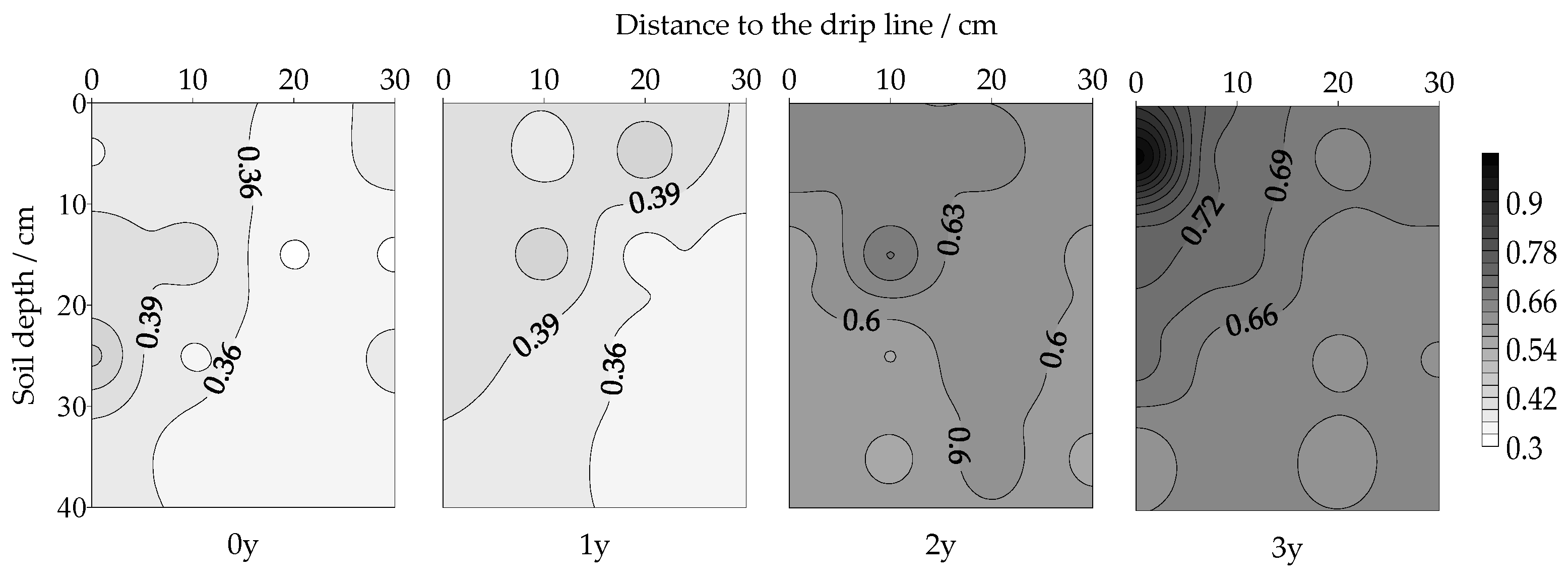



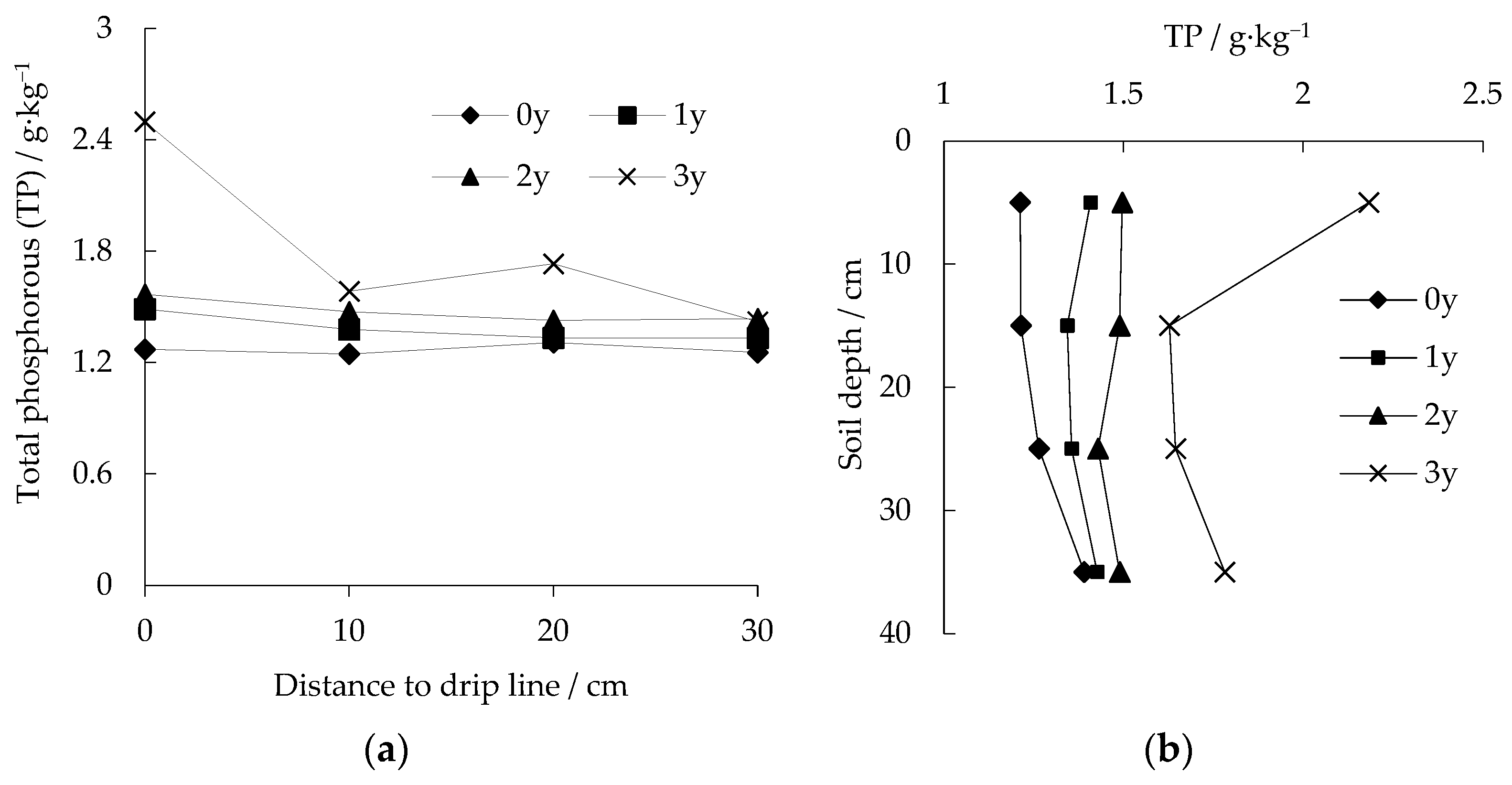

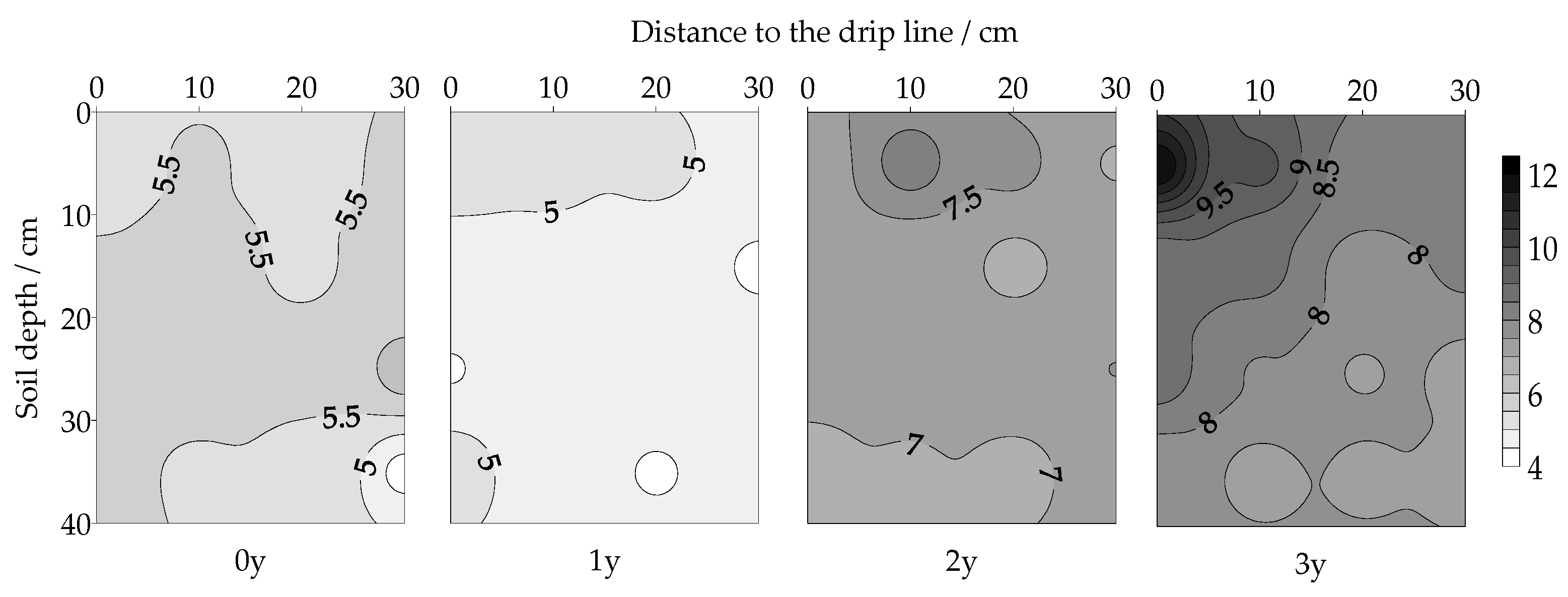
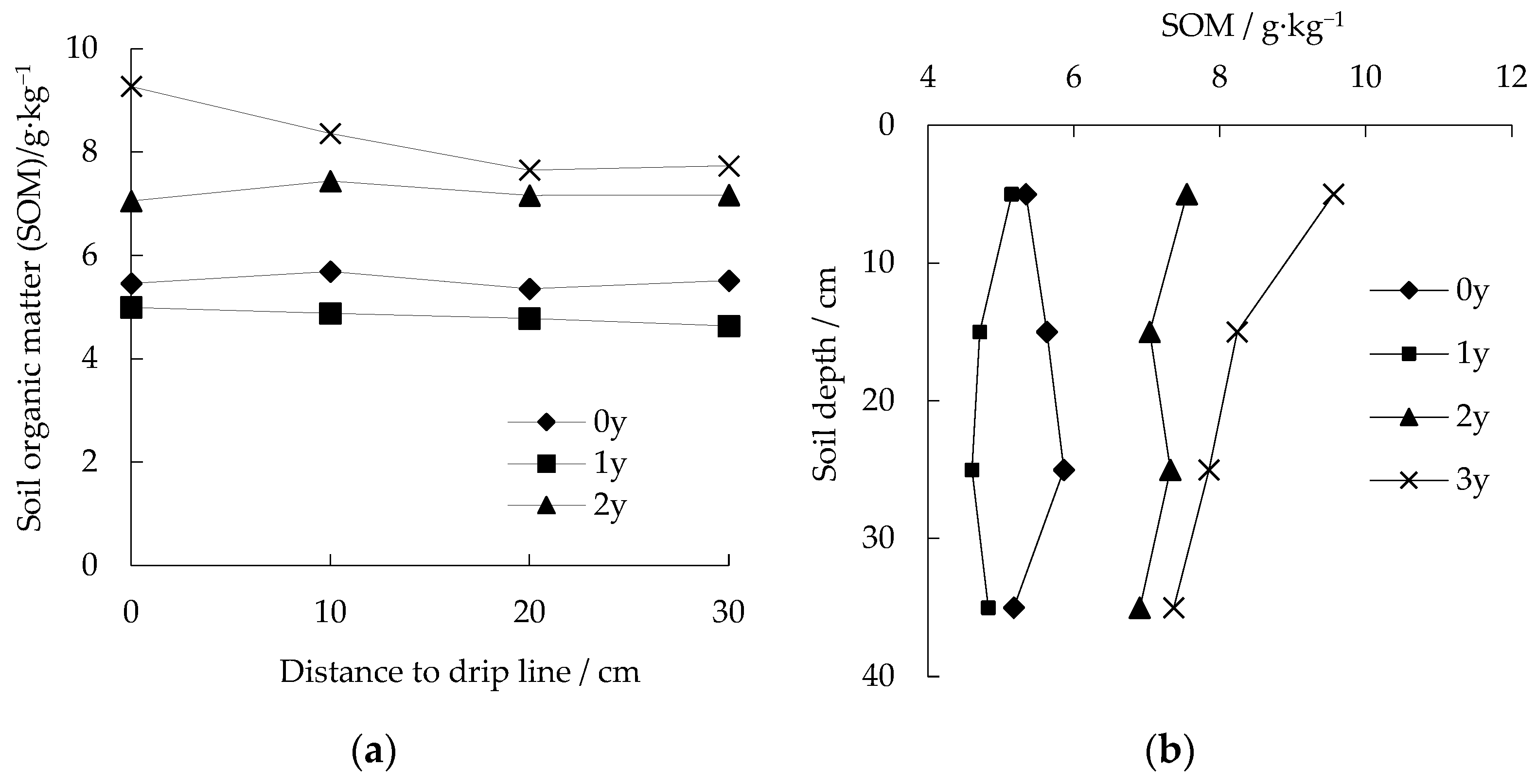
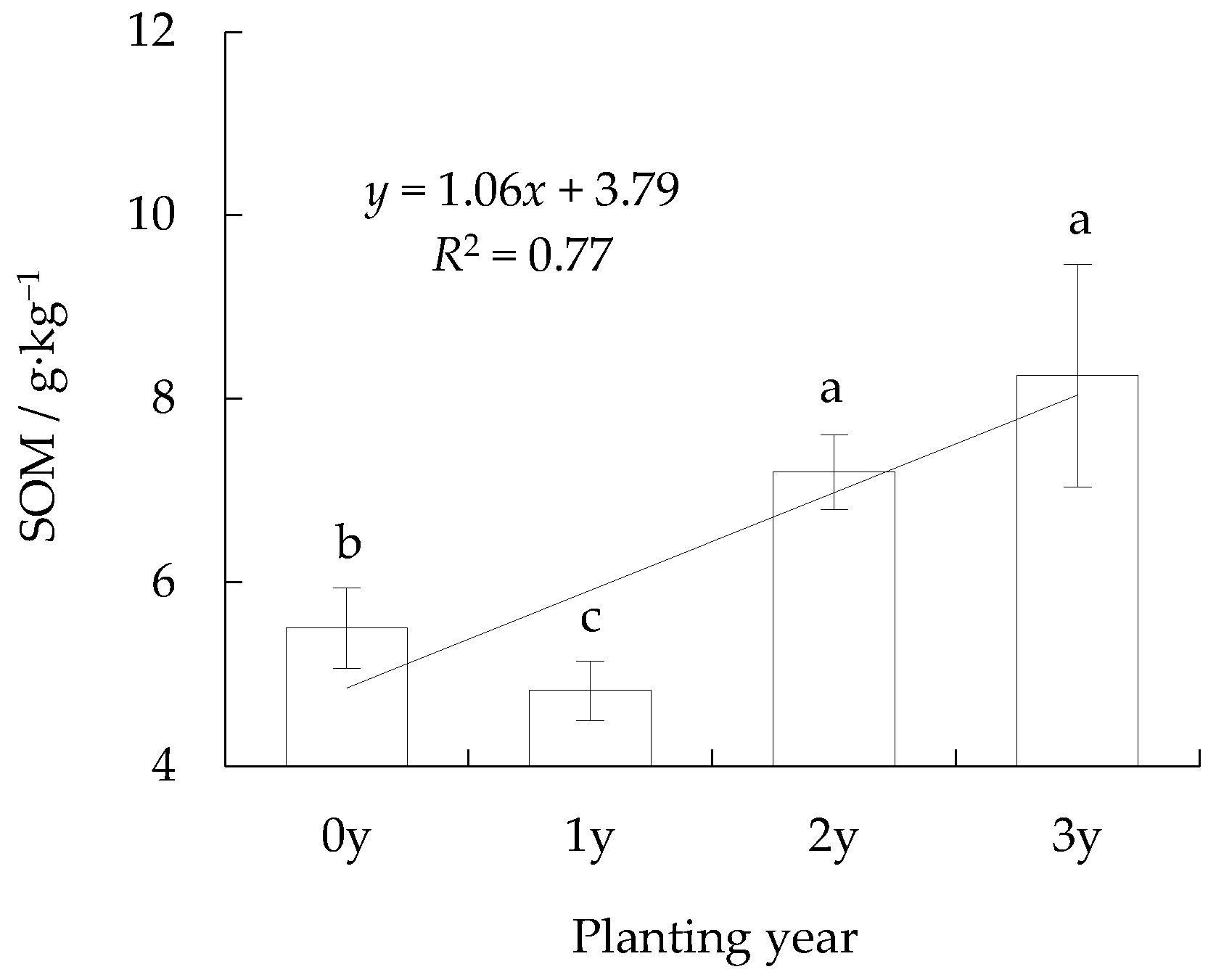
| Soil Layer /cm | pH | ECe /dS·m−1 | Major Anions/mmol·kg−1 | Major Cations/mmol·kg−1 | |||||
|---|---|---|---|---|---|---|---|---|---|
| HCO3− | SO42− | Cl− | K+ | Na+ | Ca2+ | Mg2+ | |||
| 0–10 | 7.5 | 62.3 | 6.0 | 24.5 | 260.6 | 0.5 | 219.0 | 10.0 | 20.3 |
| 10–20 | 7.8 | 13.5 | 8.0 | 1.0 | 22.5 | 0.1 | 21.8 | 1.5 | 5.1 |
| 20–30 | 7.8 | 9.0 | 8.0 | 0.5 | 13.5 | 0.1 | 8.2 | 1.5 | 4.1 |
| 30–40 | 7.8 | 10.2 | 7.5 | 2.0 | 13.5 | 0.0 | 8.2 | 2.0 | 4.1 |
| pH | TDS /g·L−1 | Major Anions/mmol·kg−1 | Major Cations/mmol·kg−1 | |||||
|---|---|---|---|---|---|---|---|---|
| HCO3− | SO42− | Cl− | K+ | Na+ | Ca2+ | Mg2+ | ||
| 7.6 | 7.27 | 7.4 | 15.3 | 79.4 | 0.3 | 96.1 | 3.3 | 7.5 |
Disclaimer/Publisher’s Note: The statements, opinions and data contained in all publications are solely those of the individual author(s) and contributor(s) and not of MDPI and/or the editor(s). MDPI and/or the editor(s) disclaim responsibility for any injury to people or property resulting from any ideas, methods, instructions or products referred to in the content. |
© 2024 by the authors. Licensee MDPI, Basel, Switzerland. This article is an open access article distributed under the terms and conditions of the Creative Commons Attribution (CC BY) license (https://creativecommons.org/licenses/by/4.0/).
Share and Cite
Dou, C.; Lv, Y.; Sun, Y.; Chen, X.; Li, Y. Assessment of Soil Nutrients in Plant Root Layer of a Saline-Sodic Soil Cropped with Lycium barbarum L. When Drip Irrigated with Saline Groundwater. Agronomy 2024, 14, 1374. https://doi.org/10.3390/agronomy14071374
Dou C, Lv Y, Sun Y, Chen X, Li Y. Assessment of Soil Nutrients in Plant Root Layer of a Saline-Sodic Soil Cropped with Lycium barbarum L. When Drip Irrigated with Saline Groundwater. Agronomy. 2024; 14(7):1374. https://doi.org/10.3390/agronomy14071374
Chicago/Turabian StyleDou, Chaoyin, Yuping Lv, Yidi Sun, Xiaoping Chen, and Yan Li. 2024. "Assessment of Soil Nutrients in Plant Root Layer of a Saline-Sodic Soil Cropped with Lycium barbarum L. When Drip Irrigated with Saline Groundwater" Agronomy 14, no. 7: 1374. https://doi.org/10.3390/agronomy14071374
APA StyleDou, C., Lv, Y., Sun, Y., Chen, X., & Li, Y. (2024). Assessment of Soil Nutrients in Plant Root Layer of a Saline-Sodic Soil Cropped with Lycium barbarum L. When Drip Irrigated with Saline Groundwater. Agronomy, 14(7), 1374. https://doi.org/10.3390/agronomy14071374






